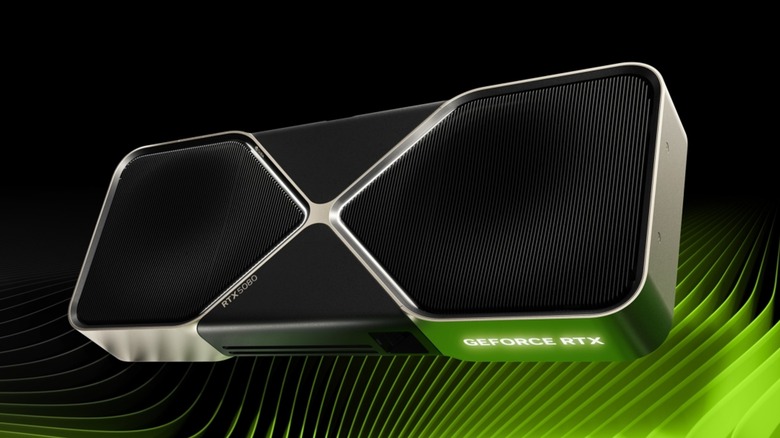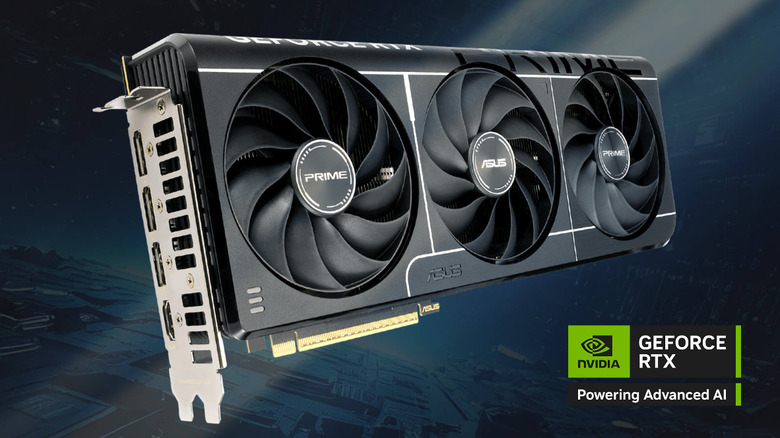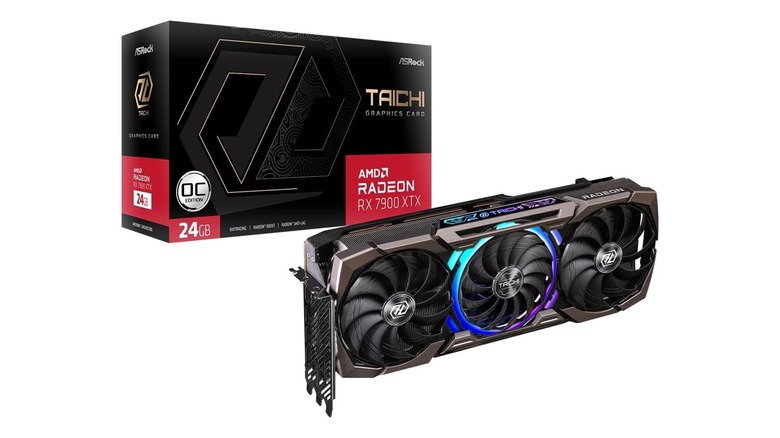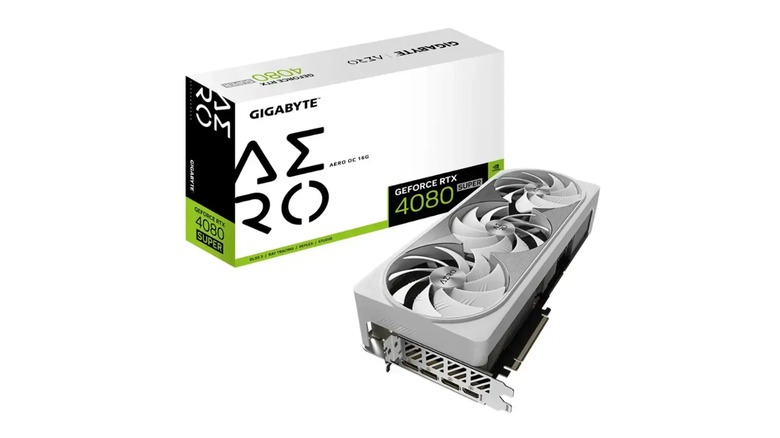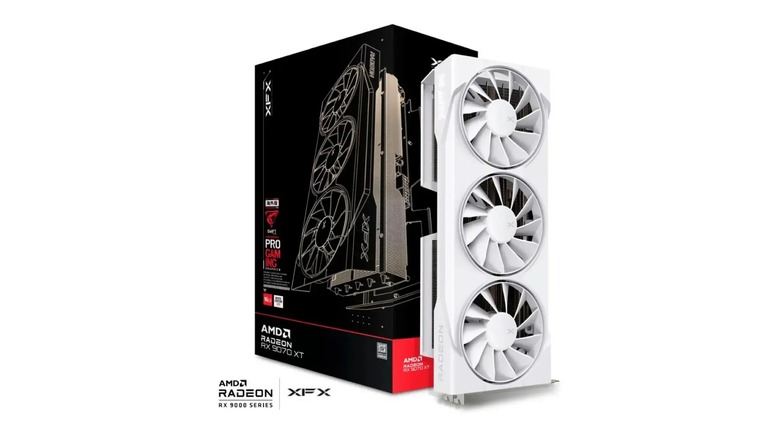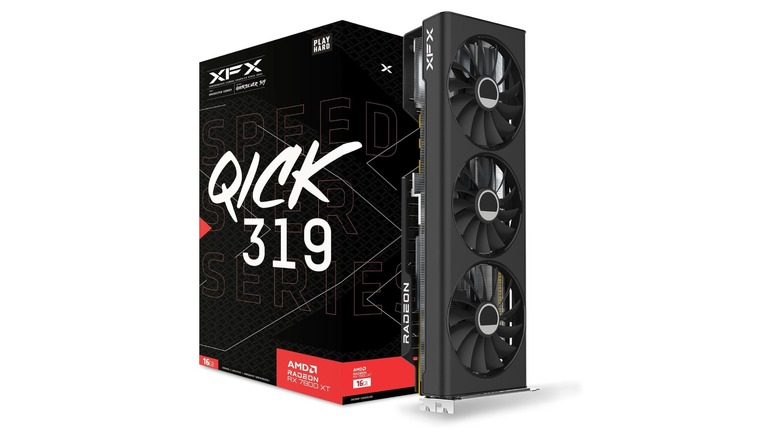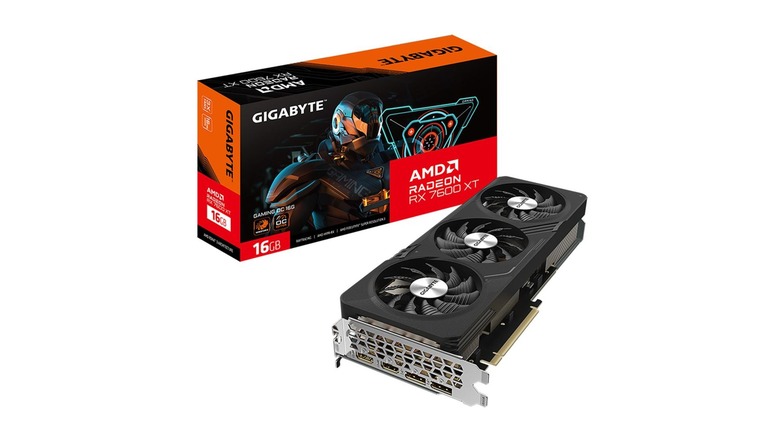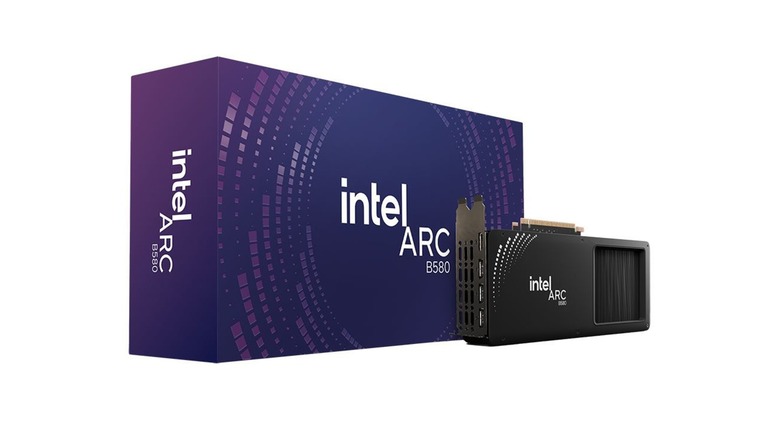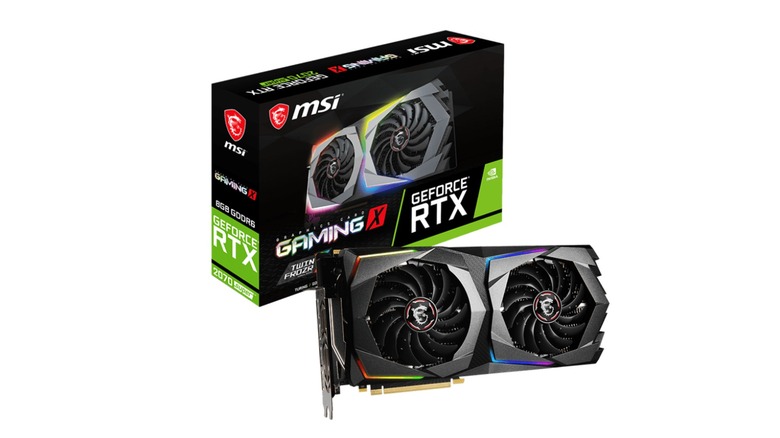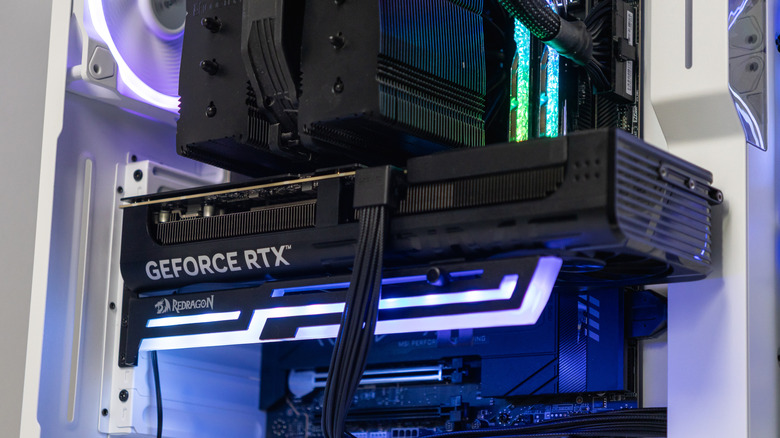10 Alternatives To The RTX 5080 GPU That Are More Readily Available
We may receive a commission on purchases made from links.
These days, it can be hard to purchase a graphics card without feeling like you're paying way more than you should. Nvidia's RTX 5080 is among the best-value high-end GPUs you can get today, even with its massive base price of $1,000. But low availability has made this card exceptionally difficult to get in any official capacity — and even if it's in stock, you'll likely be spending over $300 more for minimal benefits. Even when considering the pros of upgrading to Nvidia's new RTX 50 series graphics cards, the cost just lessens the value of those upsides.
Luckily, this card isn't the only card you're able to get. Depending on your budget and what you're using your graphics card for, there are a lot of alternatives to the RTX 5080 GPU that are both more available and less costly. If you're willing to deal with the secondhand market, there are even more choices for you, with some especially ancient models still holding up well in certain modern titles. If you have a monitor with a lower resolution or refresh rate, you might even end up paying less money for the same performance that a 5080 would give you.
5070 Ti
While its availability is pretty comparable to the 5080's, the RTX 5070 Ti has found itself to be in stock at MSRP at least once in the first week of April, which is more than what its more powerful counterpart has managed. Most of its third-party variants scrape just under the $1,000 price mark, and its base cost of $750 is at least listed on websites like NewEgg, whereas the 5080 doesn't even have a listing under $1,300. You'll still probably end up paying more than you should be spending on a GPU like this, but the 5070 Ti won't hurt your wallet as badly as the 5080.
Although some might wonder if it's worth paying extra for the RTX 5070 Ti vs. the RTX 5070, this GPU actually ends up competing well with the 5080. The card with the higher number is still obviously better, but with most modern titles, the 5070 Ti is able to handle 4K gaming at 60 FPS even with every setting maxed out. It also has the same amount of VRAM as a 5080, and it doesn't compromise on new features like DLSS 4 or multi-frame generation. If you can get a 5070 Ti, especially at its MSRP, you're unlikely to ever need a 5080 at all.
7900 XTX
The pros and cons of Nvidia vs. AMD aren't as clear-cut as they used to be, allowing the two brands to compete on more even terms. This is best shown with the Radeon 7900 XTX, which is AMD's current flagship card. Although online listings for this card don't offer the greatest deals, it's found in stock at various retailers for prices similar to — or under — the 5080's MSRP. Once you consider how capable this GPU is, it is one of the most valuable cards you can get today.
On average, the 7900 XTX isn't too far from the performance of a 4080, which means it can also hold its own against the new 50 series alternative. Between its 24 GB VRAM and fantastic 4K performance, the only place where it truly falls short is in ray tracing. Unfortunately, this will be a present issue in just about every AMD card, but the XTX can still handle it just fine at lower resolutions. For AMD fans, the 7900 XTX is the closest thing you can get to a 5080 that wasn't made by Nvidia.
Used 4080 or 4080 Super
Although they're no longer in production, the RTX 4080 and 4080 Super can easily be found from individual sellers on websites like eBay. Their prices aren't too different from what the 5080 is going for even now, but they're still usually cheaper on average. In terms of performance, both of these cards end up above the 5070 Ti, despite Nvidia's claims to the contrary. The secondhand prices of these cards are more likely to decrease as time goes on, but even at around $1,000, they're not the worst choice you could make for the sake of value.
Of course, the 40 series cards will end up with some trade-offs compared to the 50 series. These older cards will have slower memory and a lack of extra AI-driven features, which could hurt if newer titles take advantage of exclusive technologies like those. If you aren't planning to max out every setting possible, though, a secondhand 4080 or 4080 Super will be more than enough for your needs.
Used 4070 Ti Super
The RTX 4070 Ti Super is on a noticeable level below the other graphics cards mentioned here, and its secondhand pricing isn't too great, either. Even so, reputable sellers are putting its cost below the 5080's MSRP, and its overall potential isn't too far away from the second-best of the 50 series. It can handle 4K resolution at smooth frame rates without much difficulty in most cases, and its 1440p performance easily clears 60 FPS at maximum settings. It might not be worth getting over a 5070 Ti at MSRP, but the 4070 Ti Super is far more available if you're willing to get a used model.
Notably, the 4070 Ti Super is the lowest-end 40 series card with 16 GB VRAM, which is the same amount as the 5080. One of the biggest mistakes people make when buying graphics cards is not having enough VRAM, especially with newer titles requiring more on average. When using higher resolutions or ray tracing, modern games will not run well without an extra amount of video memory, sometimes even crashing entirely when settings are turned too high on less-powerful cards. For Nvidia's GPUs, the 4070 Ti Super is the last one you can get that has a good mix of modern features and future-proof performance.
9070 XT
The Radeon 9070 XT is one of AMD's latest graphics cards, and while it's not sitting at the peak of the company's repertoire, it's a very attractive option when compared to the 5080. Its performance is more in line with the 5070 Ti, but that still means it can output some stellar results at high resolutions. It struggles with ray tracing just like any other AMD card, but this won't matter if you don't bother with fancy lighting effects in the first place. It helps that the 9070 XT also has 16 GB VRAM, helping it compete with the 5080 that much better.
Unfortunately, while the 9070 XT could be the cheapest GPU released in 2025 on this list, its availability is just barely better than the 5080's. Its MSRP of around $600 is rarely presented anywhere, usually going for over $200 above that. Still, if you're willing to accept these raised prices as the actual cost, you're still likely to end up paying less than the 5080's MSRP. With luck, you can even dip under the 5070 Ti's original price, keeping you from losing out on much outside of ray tracing capabilities.
7800 XT or 7900 XT
Although it doesn't reach the heights of the XTX, the 7900 XT is a readily available card that isn't too far away from AMD's newest GPUs. It's also far more expensive, unfortunately, making its overall value pretty questionable, even if you only look at the pricier 9070 XT variants. Still, it will take just about any 1440p game you can throw at it with plenty of FPS to spare, and it won't be hurting for VRAM anytime soon with a whopping 20 GB. As our AMD Radeon RX 7900 XT review was able to show, this card can also handle 4K exceptionally well, though newer games will push it to its limits at those resolutions.
Alternatively, you could take a much smaller step with the 7800 XT. It can't quite handle 4K as well, but 1440p is once again no problem for it, and its VRAM size once again matches the 5080's. It's unfortunately another victim of availability, with pretty much every listing set far above its original $500 MSRP. But if you aren't able to get a 9070 XT at that price — and your monitor only handles lower resolutions — getting a 7800 XT can actually be worth a lot more in the long run.
7600 XT or used 4060
If you're willing to go below the high-to-mid-range for GPUs, AMD's 7600 XT honestly isn't a bad contender. You definitely won't find it at its MSRP of around $330, but even more intricate models from major graphics card brands will hardly ever go above $500. While its performance is nothing to write home about, you'll have a hard time getting it to dip below 60 FPS at 1440p, and it still manages to boast 16 GB VRAM even with its lesser power. As far as AMD GPUs go, this might be the cheapest one you can find that's still being sold by official vendors online.
You could argue that something like Nvidia's RTX 4060 would be more valuable, but its current stock is somehow even worse than the 5080's. You can at least find the card for decent sub-$400 prices on eBay, and it's able to stand up well to the 7600 XT at lower resolutions. Its VRAM is, unfortunately, very low at just 8 GB, so you'll likely need to replace it down the line if you want to keep playing the newest releases. There is a 16 GB version out there, but with how costly and unavailable that model is, you're better off making the compromise of less performance for a much better value.
Arc B580
When we compared the Intel Arc B580 to the Nvidia RTX 4060, we were surprised at how well Intel's offering could trade blows with more well-known brands. It might be a stretch to call it an alternative to the 5080, but for those of you with nothing better than a 1080p 60hz monitor, the difference is unlikely to be all that impactful. Even with only having 12 GB VRAM, that's enough to help this GPU stand tall in the realm of low-end gaming, handling the newest releases and even ray tracing with perfectly playable frame rates.
In all honesty, the biggest stretch might be labeling the Arc B580 as more readily available. You'll be hard-pressed to find a model online that isn't sold through a third-party retailer for over $350, but stores like B&H and NewEgg have sold cheaper models recently. Regardless, the extra third-party cost isn't anywhere near the RTX 50 series as a whole, so it's still a viable pick for playing the most recent games with modest-yet-reasonable settings.
Used 1660 Super or 2070 Super
If all you care about is getting the absolute baseline for performance, your best bets are either the 1660 Super or 2070 Super. We've mentioned the 1660 Super as a cheap graphics card to give your gaming PC the boost it needs, and while that boost is exceptionally small, it will still make a fair number of new titles playable at the lowest settings. A secondhand 1660 Super commonly goes for less than $120, making it an extremely strong budget pick if all you care about is playing the newest games. For some titles, though, even this might not be enough with hardware ray tracing requirements.
While a 2060 Super can handle the minimum requirements for more intensive games, a 2070 Super is a much better choice overall. Its secondhand prices hover around $200 to $300, yet it can compete with the B580 quite well in handling maxed-out 1080p gaming. Which card you get will depend on your needs, but it might not hurt to splurge on the 2070 Super above the 1660 Super. Even if there aren't currently any games that interest you with required hardware ray tracing, more brand-new releases are likely to include it as a standard through the next few years.
Used 1080 Ti
For those who simply do not care one bit about ray tracing, one of the best cards you can get is a used 1080 Ti. Even today, it can manage perfectly fine frame rates in many popular games, even standing above the 4060 and 2070 Super in some areas. Compared to those cards, it also has 11 GB VRAM, which actually helps it quite a lot for games without the ray tracing requirements. Its price isn't exactly stable on the secondhand market, but you can find it for under $300 without too much issue or even under $200 with a bit of luck.
The 1080 Ti is definitely a non-standard choice as an alternative to the 5080, with its age becoming quite apparent in the modern era. It's simultaneously able to keep up with the times with its stellar performance and VRAM buffer while being left in the dust due to ray tracing becoming more common. It's able to make plenty of sense if you're interested in older titles more than newer games or if you only really plan on checking out performance-friendly indie titles. At that point, a 5080 really isn't going to do much more for you than a 1080 Ti will.
Methodology
Graphics cards on this list were chosen based on a number of different factors, including performance, availability, price, recency, and capabilities at certain resolutions. The non-Ti 5070, for example, wasn't included on this list due to how few were in stock despite how recently it released, as well as more readily available alternatives from Nvidia itself. Likewise, the Arc B580 earned a spot on this list due to being Intel's most capable graphics card, as well as its price not being bumped up as high as rival cards.
While a 1660 Super isn't going to compete well with the 5080 in most cases, this isn't going to matter if you have a low-end monitor. High refresh rates at equally high resolutions won't do you any good if your monitor can only handle HD gaming or if a title limits its frame rate without giving you the option of changing it. Although such a high-end card might be good for future releases, you'll still end up having spent hundreds of dollars on a lot of unused power.
